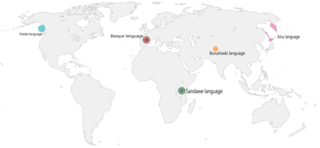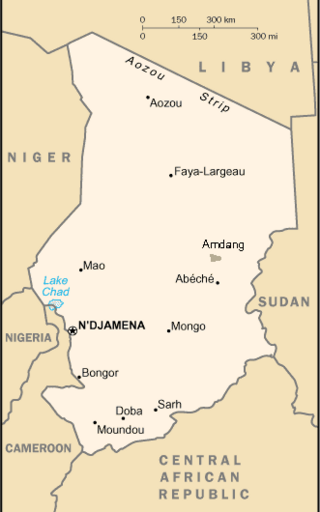
The Nilo-Saharan languages are a proposed family of African languages spoken by somewhere around 70 million speakers, mainly in the upper parts of the Chari and Nile rivers, including historic Nubia, north of where the two tributaries of the Nile meet. The languages extend through 17 nations in the northern half of Africa: from Algeria to Benin in the west; from Libya to the Democratic Republic of the Congo in the centre; and from Egypt to Tanzania in the east.

Asia is home to hundreds of languages comprising several families and some unrelated isolates. The most spoken language families on the continent include Austroasiatic, Austronesian, Japonic, Dravidian, Indo-European, Afroasiatic, Turkic, Sino-Tibetan, Kra–Dai and Koreanic. Many languages of Asia, such as Chinese, Sanskrit, Arabic,Tamil or Telugu, have a long history as a written language.

A language isolate is a language that has no demonstrable genetic relationship with another language. Basque in Europe, Ainu in Asia, Sandawe in Africa, Haida and Zuni in North America, Kanoê in South America, and Tiwi in Australia are all examples of language isolates. The exact number of language isolates is yet unknown due to insufficient data on several languages.

Amdang is a language closely related to Fur, which together constitute a branch of the Nilo-Saharan language family. It is mainly spoken in Chad, north of the town of Biltine, and sporadically elsewhere in Ouaddaï Region. There are also small colonies of speakers in Darfur near Woda'a and Fafa, and in Kordofan in the Abu Daza district and at Magrur north of Bara. Most of the ethnic group now speaks Arabic.
The Reer Barre are a tribe in the Gedo region of Ethiopia-Ogaden region on the Shabele River, near Somalia, who currently speak Somali. They are hardworking people historically a farmers and small number of them are pastoralist, they mostly keep Cows and Goats, they residents Eastern Cities of Ethiopia like jigjiga ,Gode ,Kelafo, Far-libah, Feer Feer, Mustahiil, And more others cities and town in the different part of Ethiopia, they are a large family who also have large number of Population in Shabelle region in Somalia. Reer means "family" and Barre is a name, altogether meaning "Barre family". They are descendants of Barre Abdille.

This is a list of different language classification proposals developed for the Indigenous languages of the Americas. The article is divided into North, Central, and South America sections; however, the classifications do not correspond to these divisions.

The Torricelli languages are a family of about fifty languages of the northern Papua New Guinea coast, spoken by about 80,000 people. They are named after the Torricelli Mountains. The most populous and best known Torricelli language is Arapesh, with about 30,000 speakers.
The Lower Mamberamo languages are a recently proposed language family linking two languages spoken along the northern coast of Papua province, Indonesia, near the mouth of the Mamberamo River. They have various been classified either as heavily Papuanized Austronesian languages belonging to the SHWNG branch, or as Papuan languages that had undergone heavy Austronesian influence. Glottolog 3.4 classifies Lower Mamberamo as Austronesian, while Donohue classifies it as Papuan. Kamholz (2014) classifies Warembori and Yoke each as coordinate primary subgroups of the South Halmahera–West New Guinea languages.

The South Halmahera–West New Guinea (SHWNG) languages are a branch of the Malayo-Polynesian languages, found in the islands and along the shores of the Halmahera Sea in the Indonesian province of North Maluku and of Cenderawasih Bay in the provinces of Papua and West Papua. There are 38 languages.

The pre-Indo-European languages are any of several ancient languages, not necessarily related to one another, that existed in Prehistoric Europe, Asia Minor, Ancient Iran and Southern Asia before the arrival of speakers of Indo-European languages. The oldest Indo-European language texts are Hittite and date from the 19th century BC in Kültepe, and while estimates vary widely, the spoken Indo-European languages are believed to have developed at the latest by the 3rd millennium BC. Thus, the pre-Indo-European languages must have developed earlier than or, in some cases, alongside the Indo-European languages that ultimately displaced almost all of them.
The family of Northwest Solomonic languages is a branch of the Oceanic languages. It includes the Austronesian languages of Bougainville and Buka in Papua New Guinea, and of Choiseul, New Georgia, and Santa Isabel in Solomon Islands.
Gamelaa.k.a.Curinsi or Acobu, is an unclassified and presumably extinct language of the Maranhão region of Northeastern Brazil. It was originally spoken along the Itapecuru River, Turiaçu River, and Pindaré River, with ethnic descendants reported to be living in Cabo and Vianna in Maranhão State.

The Marañón River basin, at a low point in the Andes which made it an attractive location for trade between the Inca Empire and the Amazon basin, once harbored numerous languages which have been poorly attested or not attested at all. Those of the middle reaches of the river, above the Amazon basin, were replaced in historical times by Aguaruna, a Jivaroan language from the Amazon which is still spoken there. The languages further upriver are difficult to identify, due to lack of data. The region was multilingual at the time of the Conquest, and the people largely switched to Spanish rather than to Quechua, though Quechua also expanded during Colonial times.
Payaguá (Payawá) is an extinct language of Paraguay, Argentina, and Bolivia, spoken by the Payaguá Indians. It is usually classified as one of the Guaicuruan languages, but the data is insufficient to demonstrate that.
Kĕnaboi is an extinct unclassified language of Negeri Sembilan, Malaysia that may be a language isolate or an Austroasiatic language belonging to the Aslian branch. It is attested in what appears to be two dialects, based on word lists of about 250 lexical items, presumably collected around 1870–90.
Spurious languages are languages that have been reported as existing in reputable works, while other research has reported that the language in question did not exist. Some spurious languages have been proven to not exist. Others have very little evidence supporting their existence, and have been dismissed in later scholarship. Others still are of uncertain existence due to limited research.
Glottolog is a free online bibliographic database of the world's languages. In addition to listing linguistic materials describing individual languages, the database also contains the most up-to-date language affiliations based on the work of expert linguists.

Baduy is one of the Sundanese-Baduy languages spoken predominantly by the Baduy people. It is conventionally considered a dialect of Sundanese, but it is often considered a separate language due to its diverging vocabulary and cultural reasons that differ from the rest of the Sundanese people. Native speakers of the Baduy language are spread in regions around the Mount Kendeng, Rangkasbitung district of Lebak Regency and Pandeglang Regency, Banten Province, Indonesia. It is estimated that there are 11,620 speakers as of 2015.









